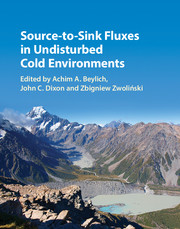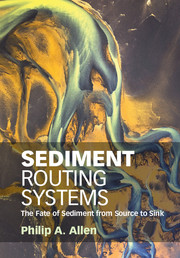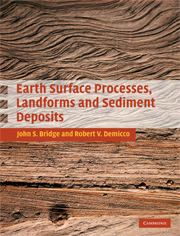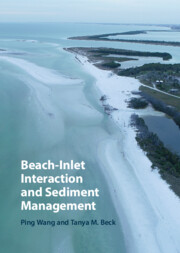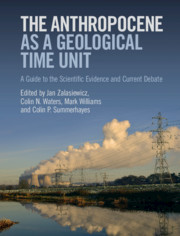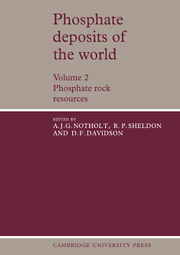Source-to-Sink Fluxes in Undisturbed Cold Environments
£144.00
- Editors:
- Achim A. Beylich, Geological Survey of Norway
- John C. Dixon, University of Arkansas
- Zbigniew Zwoliński, Adam Mickiewicz University
- Date Published: July 2016
- availability: Available
- format: Hardback
- isbn: 9781107068223
£
144.00
Hardback
Other available formats:
eBook
Looking for an inspection copy?
This title is not currently available on inspection
-
Amplified climate change and ecological sensitivity of polar and cold climate environments are key global environment issues. Understanding how projected climate change will alter surface environments in these regions is only possible when present day source-to-sink fluxes can be quantified. The book provides the first global synthesis and integrated analysis of environmental drivers and quantitative rates of solute and sedimentary fluxes in cold environments, and the likely impact of projected climate change. The focus on largely undisturbed cold environments allows ongoing climate change effects to be detected and, moreover, distinguished from anthropogenic impacts. A novel approach for co-ordinated and integrative process geomorphic research is introduced to enable better comparison between studies. This highly topical and multidisciplinary book, which includes case studies covering Arctic, Antarctic, and alpine environments, will be of interest to graduate students and researchers in the fields of geomorphology, sedimentology and global environmental change.
Read more- Presents a synthesis of the key findings from the work conducted by the global IAG/AIG SEDIBUD Programme, which was established with the aim of improving understanding of how processes and environments in cold climate regions will respond to changing climate
- Provides the first quantitative overview of global source-to-sink fluxes in cold climate environments, allowing for direct comparisons with current research
- Introduces a novel approach for co-ordinated and integrative research on denudational Earth surface processes and the effects of climate change in undisturbed cold climate environments
Reviews & endorsements
'… the book provides a large amount of novel information. Ultimately, it is worthwhile to bring this information to international audiences, particularly considering that some of the papers report outstanding scientific advances, with the first global synthesis and integrated analysis of sediment and solute transport in Greenland, Antarctica and the Himalaya. This book could provide great supplementary reading for hydrology science course at university level and will certainly be of special interest to experts and professionals.' Sergey Chalov, Polar Record
Customer reviews
Not yet reviewed
Be the first to review
Review was not posted due to profanity
×Product details
- Date Published: July 2016
- format: Hardback
- isbn: 9781107068223
- length: 419 pages
- dimensions: 285 x 222 x 23 mm
- weight: 1.35kg
- contains: 160 b/w illus. 35 maps 37 tables
- availability: Available
Table of Contents
Preface
Part I. Solute and Sedimentary Fluxes and Budgets in Changing Cold Climate Environments:
1. Introduction to the theme
2. The IAG/AIG SEDIBUD (Sediment Budgets in Cold Environments) programme
Part II. Climate Change in Cold Environments and General Implications for Contemporary Solute and Sedimentary Fluxes:
3. The changing cryosphere – implications for solute and sedimentary fluxes in cold climate environments
4. Changes in vegetation cover and implications for solute and sedimentary fluxes in cold climate environments
Part III. Solute and Sedimentary Fluxes in Sub-Arctic and Arctic Environments:
5. Contemporary solute and sedimentary fluxes in Arctic and Sub-Arctic environments: current knowledge
6. The use of dendrogeomorphology to recognize the spatio-temporal distribution of snow avalanches in northern Iceland – case studies from Dalsmynni, Ljósavatnsskarð and Fnjóskadalur
7. A contemporary assessment of sediment and solute transfers in Kärkevagge, Swedish Lapland
8. Hillslope processes and related sediment fluxes on a fine-grained scree slope of Eastern Canada
9. Sediment and solute transport from Greenland
10. Measurements of bedload flux in a high Arctic environment
11. Solute and particulate fluxes in catchments in Spitsbergen
12. Sediment and solute fluxes at the Igarka field site, Russian Sub-Arctic
13. Variability and controls of solute and sedimentary fluxes in Sub-Arctic and Arctic environments
Part IV. Solute and Sedimentary Fluxes in Sub-Antarctic and Antarctic Environments:
14. Environmental impact on contemporary solute and sedimentary fluxes in Antarctica: current knowledge
15. Solute and solid cascade system in the Antarctic oases
16. Environmental controls on sediment composition and particle fluxes over the Antarctic continental shelf
17. Solute and sedimentary fluxes on King George Island
18. Dynamics of the Antarctica ice cap
19. Solute and sediment fluxes from rivers and streams in the McMurdo Dry Valleys, Antarctica
Part V. Solute and Sedimentary Fluxes in Alpine/Mountain Environments:
20. Chemical denudation in partly glacierized mountain catchments of the fjord landscape in western Norway: contemporary rates, environmental controls and possible effects of climate change
21. Sediment delivery from headwater slope systems and relief development in steep mountain valleys in western Norway
22. Suspended sediment dynamics in the proglacial zone of the rapidly retreating Castle Creek Glacier, British Columbia, Canada
23. Sedimentary fluxes in Himalaya
24. Rates of slope and channel processes in the Reintal Valley, Bavarian Alps
25. Comparative analysis of sediment routing in two different alpine catchments
26. Controls and variability of solute and sedimentary fluxes in alpine/mountain environments
Part VI. Quantitative Analysis of Solute and Sedimentary Fluxes in Cold Climate Environments:
27. Environmental drivers, spatial variability and rates of chemical and mechanical fluvial denudation in selected glacierized and non-glacierized cold climate catchment geosystems: from coordinated field data generation to integration and modeling
28. Summary of key findings from Arctic, Antarctic and mountain environments
Index.-
General Resources
Find resources associated with this title
Type Name Unlocked * Format Size Showing of
This title is supported by one or more locked resources. Access to locked resources is granted exclusively by Cambridge University Press to lecturers whose faculty status has been verified. To gain access to locked resources, lecturers should sign in to or register for a Cambridge user account.
Please use locked resources responsibly and exercise your professional discretion when choosing how you share these materials with your students. Other lecturers may wish to use locked resources for assessment purposes and their usefulness is undermined when the source files (for example, solution manuals or test banks) are shared online or via social networks.
Supplementary resources are subject to copyright. Lecturers are permitted to view, print or download these resources for use in their teaching, but may not change them or use them for commercial gain.
If you are having problems accessing these resources please contact [email protected].
Sorry, this resource is locked
Please register or sign in to request access. If you are having problems accessing these resources please email [email protected]
Register Sign in» Proceed
You are now leaving the Cambridge University Press website. Your eBook purchase and download will be completed by our partner www.ebooks.com. Please see the permission section of the www.ebooks.com catalogue page for details of the print & copy limits on our eBooks.
Continue ×Are you sure you want to delete your account?
This cannot be undone.
Thank you for your feedback which will help us improve our service.
If you requested a response, we will make sure to get back to you shortly.
×
